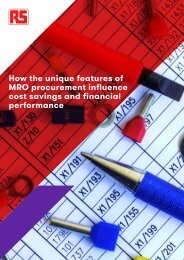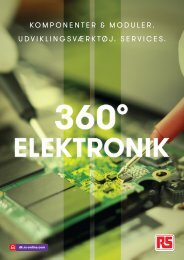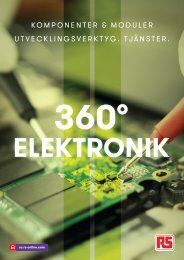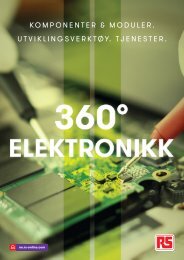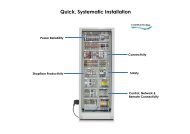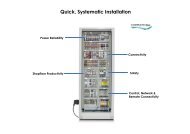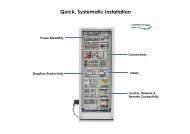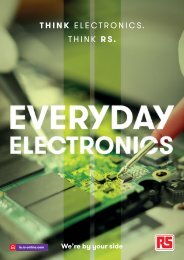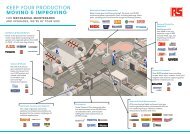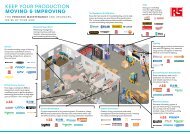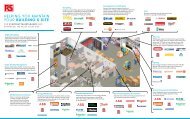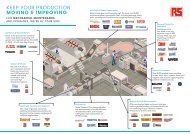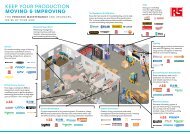Electronic Solutions PH
You also want an ePaper? Increase the reach of your titles
YUMPU automatically turns print PDFs into web optimized ePapers that Google loves.
adoption around the globe, and Industry<br />
4.0 and the industrial application of the<br />
internet of things (IIoT) are well-suited.<br />
Two of the founding principles of Industry<br />
4.0 are interconnection and information<br />
transparency. The IIoT is at the very heart of<br />
interconnection. The basic premise behind<br />
interconnection is to<br />
be able to digitally<br />
link manufacturing<br />
and production<br />
assets together<br />
via monitoring,<br />
control and analysis<br />
applications. The<br />
interconnection meant<br />
that any item of<br />
industrial automation<br />
or process equipment<br />
could provide data<br />
in real-time about its<br />
operational status<br />
and performance.<br />
Interconnection<br />
is also a two-way<br />
communication,<br />
allowing control<br />
of machinery and<br />
plant automatically<br />
or through human<br />
intervention.<br />
The collection of<br />
data across a<br />
whole production facility creates masses<br />
of data points, which when aggregated<br />
would yield the critical manufacturing<br />
management metrics of operational<br />
efficiency (OE) and overall equipment<br />
effectiveness (OEE) with ease.<br />
Keeping any factory or production process<br />
running, with high levels of efficiency and<br />
effectiveness depends on reliable machinery.<br />
Unfortunately, anything mechanical tends<br />
to have parts that wear or fail over time. For<br />
a linear production process, the failure of<br />
one item of machinery can stop the whole<br />
factory, so over the years formal maintain,<br />
repair, and operate (MRO) regimes have<br />
become necessary to ensure production<br />
equipment keeps running. Thanks to<br />
the IIoT, implementation of a preventive<br />
maintenance routine is possible that<br />
gives plant management early warning to<br />
potential equipment failures and to be able<br />
to schedule maintenance intervention for<br />
when it is operationally most effective.<br />
Acquisition of the critical data required for<br />
both operational and maintenance purposes<br />
comes from sensors deployed on production<br />
assets. This is where the semiconductor<br />
manufacturers come into force, the sensor<br />
development they have undertaken can be<br />
used to detect the common key indicators<br />
of performance levels through signature<br />
analysis. Sensors can detect vibration,<br />
temperature, humidity, sound and a<br />
whole host of other environmental factors.<br />
Many of these can be used to determine<br />
the operation life of assets, but more<br />
importantly flag any issues that arise before<br />
unexpected costly breakdown occurs.<br />
Also, inspection sensors such as camera<br />
sensors function as inputs to image<br />
recognition systems that check, for example,<br />
if a brand label affixed to a bottle does not<br />
conform to correct placement tolerances.<br />
STMicroelectronics is helping customers<br />
to evaluate predictive maintenance<br />
implementation with the release of their<br />
STWIN prototyping evaluation board for<br />
IIoT applications (RS Stock No. 193-9794).<br />
This ultimately allows the user to deliver<br />
the benefits of condition monitoring<br />
on key critical industrial assets.<br />
STWIN from STMicroelectronics<br />
There is a wide range of different sensor<br />
technologies in use today, from simple<br />
discrete thermistors to detect temperature,<br />
to complex micro-electromechanical (MEMS)<br />
sensors used to detect acceleration forces.<br />
The vast majority of sensor outputs today<br />
are processed into the digital domain<br />
within the sensor and then transmitted<br />
across wired or wireless networks to the<br />
host control and monitoring system.<br />
Technology innovations<br />
will drive Industry 5.0<br />
Before many manufacturing organisations<br />
have even completed their Industry 4.0<br />
deployments, the industry has started<br />
talking about Industry 5.0. Industry 5.0<br />
offers the potential to bring the human<br />
back into the manufacturing loop, a<br />
notable omission in Industry 4.0.<br />
Implementing Industry 4.0 hasn't been<br />
without its challenges. Factory floor space<br />
is at a premium across the world, so many<br />
manufacturing operations found themselves<br />
having to squeeze more and more electronicsbased<br />
systems into existing control cabinets.<br />
In most cases, these were already nearly<br />
full, so packing more tech into a spaceconstrained<br />
cabinet required more innovation.<br />
Established industrial automation equipment<br />
manufacturers needed to make their PLCs<br />
and control cards more functionally dense,<br />
more power-efficient, and slimmer. Thankfully,<br />
the semiconductor industry provided the<br />
answers with innovations that offered<br />
higher levels of functional integration; for<br />
example, a four-channel analogue-to-digital<br />
converter (ADC) complete with a low noise<br />
isolated DC/DC converter compared to a<br />
previous single-channel ADC. Intelligent<br />
power management ICs, and driving higher<br />
power conversion efficiencies by using widebandgap<br />
process technologies, reduce the<br />
amount of waste heat requiring dissipation,<br />
further reducing overall system size.<br />
For Industry 5.0, innovations from the<br />
semiconductor industry will continue to be<br />
in demand. One aspect of Industry 5.0 is<br />
that for some processes, robots will work<br />
alongside skilled human counterparts. There<br />
has been a lot of research into the use of<br />
collaborative robots and how they need<br />
to interact with humans nearby. Safety<br />
barriers usually surround industrial robots to<br />
prevent accidents; however, to be productive<br />
cobots will need to work beside humans,<br />
introducing more sensing requirements.<br />
Another lesson learnt from Industry 4.0<br />
and its use of IIoT centres around the<br />
amount of data transmitted, latency, and<br />
cloud-compute capabilities. Many sensors<br />
do not include any control element; they<br />
send data to the production management<br />
system at a set frequency. Aggregated<br />
together with hundreds and potentially<br />
thousands of sensors in a single site, this<br />
can represent a significant data bandwidth<br />
requirement. Also, the communications<br />
node-cloud-control latency involved in<br />
receiving sensor data to taking action can<br />
be substantial, removing the possibility of<br />
cloud-based control for some tasks. New<br />
types of sensors need to not only sense but<br />
also infer a control action. Likewise, local<br />
gateway aggregators could have a degree of<br />
devolved autonomy passed to them to control<br />
specific tasks within predefined bounds.<br />
The semiconductor industry is responding<br />
with low power microcontrollers that include<br />
sensing elements and enough compute<br />
resource to run task-specific artificial<br />
intelligence algorithms. These devices<br />
contain a computer hardware architecture<br />
optimised for inference at the edge. Sensors<br />
are becoming more intelligent, being able<br />
to predict, for example, if a human's hand<br />
might be within the path of the cobot's<br />
intended movement. Another example<br />
is using a machine learning algorithm<br />
to listen to the output from an audio<br />
sensor mounted within a motor housing<br />
to detect early signs of bearing wear.<br />
Constant innovation<br />
Our rapidly changing environment together<br />
with technological developments is giving<br />
rise to the connected philosophy of Industry<br />
4.0 and beyond. The ability to act on data<br />
gathered from sensors cuts across all<br />
aspects of our life, from consumables and<br />
wearables to healthcare and industry.<br />
The realisation of the founding principles<br />
of 4th (and 5th) industrial revolution is<br />
attributed to the growing adoption of<br />
industrial automation. With this, the part that<br />
semiconductor manufacturers play in the<br />
world of industrial sensing is only set to grow.<br />
3



